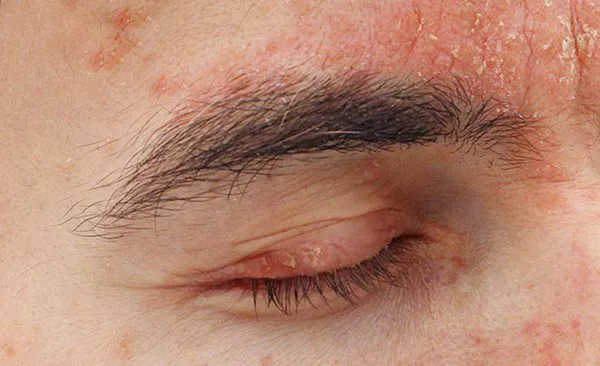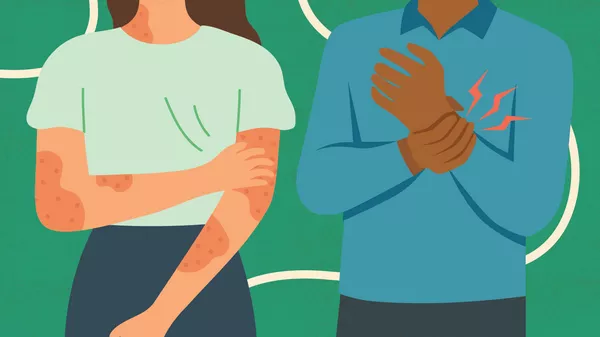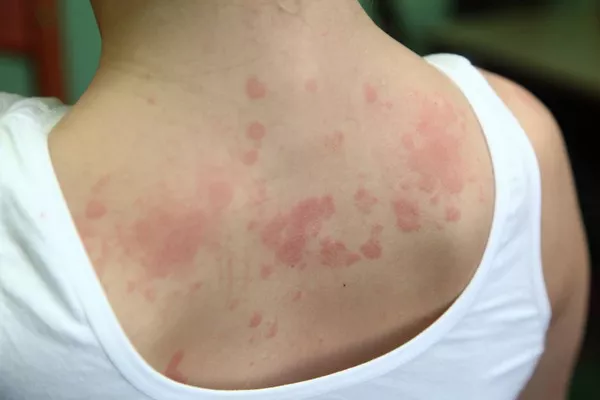Psoriasis is a chronic skin condition characterized by the rapid buildup of skin cells, leading to scaling on the skin’s surface. It is typically associated with red patches covered with thick, silvery scales. While psoriasis commonly affects areas like the elbows, knees, and scalp, it can also appear in more sensitive regions, such as the eyelids. Treating psoriasis on the eyelids poses unique challenges due to the thin, delicate skin in this area and the proximity to the eyes. This article explores various treatment options and considerations for managing psoriasis on the eyelids.
Understanding Psoriasis on the Eyelids
Psoriasis on the eyelids manifests as red, scaly, and often itchy patches on the upper or lower eyelids. The symptoms can cause discomfort and affect the overall appearance, leading to psychological distress. Given the sensitivity of the eyelid skin and its function in protecting the eyes, treatment must be approached with caution.
Symptoms and Diagnosis
The symptoms of eyelid psoriasis include:
- Red, inflamed skin on the eyelids
- Scaly, flaky skin that may peel
- Itching or burning sensation
- Swollen or puffy eyelids
- Crusting at the base of the eyelashes
Diagnosing psoriasis on the eyelids involves a thorough examination by a dermatologist, who may take a skin biopsy to confirm the diagnosis. It is essential to differentiate psoriasis from other conditions such as eczema or dermatitis, as the treatment approaches can differ.
Topical Treatments
Topical treatments are often the first line of defense in managing eyelid psoriasis. These treatments are applied directly to the affected area and can help reduce inflammation, slow down the rapid skin cell turnover, and alleviate symptoms.
Corticosteroids
Corticosteroids are potent anti-inflammatory medications that can significantly reduce the redness and swelling associated with psoriasis. Due to the delicate nature of eyelid skin, low-potency corticosteroids such as hydrocortisone are usually prescribed. These should be used sparingly and under the supervision of a healthcare professional to avoid potential side effects, including thinning of the skin and increased intraocular pressure, which can lead to glaucoma.
Calcineurin Inhibitors
Calcineurin inhibitors, such as tacrolimus (Protopic) and pimecrolimus (Elidel), are non-steroidal medications that suppress the immune response causing psoriasis. These are particularly useful for sensitive areas like the eyelids because they do not cause skin thinning. Studies have shown that calcineurin inhibitors can be effective in reducing the symptoms of eyelid psoriasis with minimal side effects. However, their use should be monitored closely by a healthcare provider due to potential risks, such as an increased risk of lymphoma with long-term use.
Moisturizers and Emollients
Keeping the eyelid skin hydrated is crucial in managing psoriasis. Moisturizers and emollients can help maintain the skin barrier, reduce scaling, and alleviate itching. Products that are free of fragrances and irritants are preferred to avoid further irritation. Petroleum jelly and mineral oil are examples of effective emollients for sensitive skin areas like the eyelids.
Systemic Treatments
For moderate to severe cases of eyelid psoriasis, or when topical treatments are not effective, systemic treatments may be considered. These treatments affect the entire body and can help control psoriasis symptoms more broadly.
SEE ALSO: Does Psoriatic Arthritis Cause Hip Pain?
Oral Medications
Oral medications such as methotrexate, cyclosporine, and acitretin are often prescribed for severe psoriasis. These drugs work by suppressing the immune system and slowing down the overproduction of skin cells. While effective, they come with potential side effects, including liver damage, kidney problems, and an increased risk of infections. Regular monitoring by a healthcare provider is essential when using these medications.
Biologic Therapies
Biologics are a newer class of systemic treatments that target specific components of the immune system involved in psoriasis. Drugs like adalimumab (Humira), etanercept (Enbrel), and ustekinumab (Stelara) have shown effectiveness in treating psoriasis, including difficult-to-treat areas like the eyelids. Biologics are administered via injection or intravenous infusion and generally have fewer side effects compared to traditional systemic treatments. However, they are expensive and require ongoing treatment to maintain results.
Phototherapy
Phototherapy, or light therapy, involves exposing the skin to ultraviolet (UV) light under medical supervision. This treatment can help slow down the growth of skin cells and reduce inflammation. Narrowband UVB phototherapy is commonly used for psoriasis and can be effective for eyelid psoriasis as well. However, due to the sensitivity of the eyelids and the risk of eye damage, phototherapy should be administered with caution and proper eye protection.
Lifestyle and Home Remedies
In addition to medical treatments, several lifestyle modifications and home remedies can help manage psoriasis on the eyelids.
Stress Management
Stress is a known trigger for psoriasis flare-ups. Practicing stress-reduction techniques such as yoga, meditation, and deep breathing exercises can help manage stress levels and potentially reduce the frequency and severity of psoriasis outbreaks.
Healthy Diet
A balanced diet rich in anti-inflammatory foods can support overall skin health and potentially reduce psoriasis symptoms. Omega-3 fatty acids, found in fish oil and flaxseed, have anti-inflammatory properties that may benefit individuals with psoriasis. Avoiding foods that can trigger inflammation, such as processed foods and those high in sugar, can also be helpful.
Gentle Skincare Routine
Adopting a gentle skincare routine that avoids harsh chemicals and irritants is essential for managing eyelid psoriasis. Using mild, fragrance-free cleansers and moisturizers can help protect the skin barrier and reduce irritation. It is also important to avoid rubbing or scratching the eyelids, as this can exacerbate symptoms.
Humidifiers
Using a humidifier to add moisture to the air can help prevent the skin from becoming too dry, especially in colder months when indoor heating can reduce humidity levels. Maintaining a humid environment can help keep the skin on the eyelids hydrated and reduce scaling.
Complementary and Alternative Therapies
Some individuals find relief from psoriasis symptoms through complementary and alternative therapies. While these approaches should not replace conventional treatments, they can be used in conjunction to enhance overall management.
Aloe Vera
Aloe vera has natural anti-inflammatory and soothing properties that can help alleviate the symptoms of psoriasis. Applying pure aloe vera gel to the eyelids can reduce redness and scaling. It is important to use products free from additives and fragrances to avoid irritation.
Apple Cider Vinegar
Apple cider vinegar has been used as a natural remedy for various skin conditions, including psoriasis. Its antimicrobial properties can help reduce itching and scaling. Diluting apple cider vinegar with water and applying it to the affected area with a cotton ball can provide relief. However, caution is advised as it can cause irritation if used undiluted.
Omega-3 Supplements
Omega-3 fatty acid supplements, such as fish oil, can have anti-inflammatory effects that may benefit individuals with psoriasis. Including these supplements in the diet can support skin health and potentially reduce the severity of symptoms. Consulting with a healthcare provider before starting any new supplement is recommended.
Turmeric
Turmeric, a spice known for its anti-inflammatory properties, has been studied for its potential benefits in managing psoriasis. Curcumin, the active ingredient in turmeric, can be taken as a supplement or added to the diet. Some individuals also use turmeric topically by mixing it with water or aloe vera to create a paste that can be applied to the affected area.
Consulting with Healthcare Providers
Given the complexities and potential risks associated with treating psoriasis on the eyelids, it is crucial to consult with healthcare providers, including dermatologists and ophthalmologists. They can provide personalized treatment plans and monitor for any adverse effects, ensuring that the chosen therapies are both effective and safe.
Regular Follow-Up
Regular follow-up appointments with healthcare providers are essential for monitoring the progress of treatment and making necessary adjustments. This ongoing care helps ensure that the treatment plan remains effective and any side effects are promptly addressed.
Patient Education
Educating patients about the nature of psoriasis and the importance of adhering to treatment plans is crucial. Patients should be informed about the potential side effects of treatments and the importance of avoiding triggers that can exacerbate symptoms.
Conclusion
Psoriasis on the eyelids presents unique challenges due to the sensitivity of the skin and the proximity to the eyes. A combination of topical treatments, systemic therapies, lifestyle modifications, and complementary approaches can help manage the symptoms effectively. Consulting with healthcare providers is essential to develop a personalized and safe treatment plan. With proper management, individuals with eyelid psoriasis can achieve significant relief and maintain a better quality of life.
Related Topics:



























